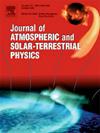Automatic Detection of Sunspots on full-disk continuum images using the MiniMax Optimization and Feature Extraction
IF 1.9
4区 地球科学
Q3 GEOCHEMISTRY & GEOPHYSICS
Journal of Atmospheric and Solar-Terrestrial Physics
Pub Date : 2025-08-19
DOI:10.1016/j.jastp.2025.106605
引用次数: 0
Abstract
Novel contributions engaging white and black-box models for Sunspot detection neglect optimization which is highly essential in solar activity monitoring. This demanded the quest for automated mathematical programming methods, warranting accurate forecasting of solar activity. Accordingly, in this paper, an energy-optimized adaptive curve fitting sunspot detection model coined Sunspot Attribute Extraction via Energy-tuned Minimax Optimization (SAEEMO) is introduced for characterizing diverse solar constituents followed by feature extraction from full disk images. SAEEMO initially considers the overall image energy as the sum of energies concerned with the solar disk to distinguish the solar variations that are intensity enhanced, facilitating segmentation. Later, the Sunspots are further disintegrated into umbra and penumbra, characterized as edge sensitivity and regularization terms, and adaptively thresholded using the novel energy-based Minimax optimizer. The adopted energy function packs the intensity variations within the Minimax bounds to render a globally optimal solution in an iterative manner using the line search operation. SAEEMO’s Receiver Operating Characteristics (ROC) investigation on Helioseismic and Magnetic Imager (HMI) continuum images obtained from Solar Dynamics Observatory (SDO) reveals its preservative and distinctive nature in detecting and characterizing diverse solar features. Also, relative investigations of the extracted solar features with the catalogs of Debrecen Photoheliographic Data (DPD), Heliophysics Feature Catalog (HFC), Sunspot Index and Long-term Solar Observations (SILSO), and Space Weather Prediction Center (SWPC) demonstrate SAEEMO’s consistency.
基于极大极小优化和特征提取的全圆盘连续图像上太阳黑子的自动检测
利用白盒和黑盒模型对太阳黑子探测忽略优化的新贡献,这在太阳活动监测中是非常重要的。这就要求寻求自动化的数学规划方法,保证对太阳活动的准确预测。为此,本文提出了一种能量优化自适应曲线拟合的太阳黑子检测模型——基于能量调优极大极小优化的太阳黑子属性提取(SAEEMO),该模型用于对太阳不同成分进行特征提取,并对全盘图像进行特征提取。SAEEMO首先将整体图像能量视为与太阳盘有关的能量之和,以区分强度增强的太阳变化,便于分割。然后,将太阳黑子进一步分解为本影和半影,利用边缘灵敏度和正则化项进行特征化,并采用基于能量的Minimax优化器自适应阈值化。所采用的能量函数将强度变化包在极小极大边界内,利用线搜索操作以迭代方式呈现全局最优解。SAEEMO对太阳动力学观测台(SDO)获得的日震和磁成像仪(HMI)连续图像进行了接收机工作特征(ROC)研究,揭示了其在探测和表征太阳各种特征方面的保存性和独特性。将提取的太阳特征与德布雷森太阳物理特征目录(DPD)、太阳物理特征目录(HFC)、太阳黑子指数和长期太阳观测(SILSO)以及空间天气预报中心(SWPC)进行对比研究,验证了SAEEMO的一致性。
本文章由计算机程序翻译,如有差异,请以英文原文为准。
求助全文
约1分钟内获得全文
求助全文
来源期刊

Journal of Atmospheric and Solar-Terrestrial Physics
地学-地球化学与地球物理
CiteScore
4.10
自引率
5.30%
发文量
95
审稿时长
6 months
期刊介绍:
The Journal of Atmospheric and Solar-Terrestrial Physics (JASTP) is an international journal concerned with the inter-disciplinary science of the Earth''s atmospheric and space environment, especially the highly varied and highly variable physical phenomena that occur in this natural laboratory and the processes that couple them.
The journal covers the physical processes operating in the troposphere, stratosphere, mesosphere, thermosphere, ionosphere, magnetosphere, the Sun, interplanetary medium, and heliosphere. Phenomena occurring in other "spheres", solar influences on climate, and supporting laboratory measurements are also considered. The journal deals especially with the coupling between the different regions.
Solar flares, coronal mass ejections, and other energetic events on the Sun create interesting and important perturbations in the near-Earth space environment. The physics of such "space weather" is central to the Journal of Atmospheric and Solar-Terrestrial Physics and the journal welcomes papers that lead in the direction of a predictive understanding of the coupled system. Regarding the upper atmosphere, the subjects of aeronomy, geomagnetism and geoelectricity, auroral phenomena, radio wave propagation, and plasma instabilities, are examples within the broad field of solar-terrestrial physics which emphasise the energy exchange between the solar wind, the magnetospheric and ionospheric plasmas, and the neutral gas. In the lower atmosphere, topics covered range from mesoscale to global scale dynamics, to atmospheric electricity, lightning and its effects, and to anthropogenic changes.
 求助内容:
求助内容: 应助结果提醒方式:
应助结果提醒方式:


